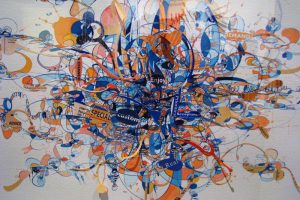Aurora Robson, Sculptor
 Brooklyn-based sculptor Aurora Robson creates organic-form sculptures almost entirely from hand-cut plastic bottles that were found, donated or salvaged from landfills. After more than a decade working closely with all types of bottles, Robson remains dedicated to exposing the negative effects of plastic trash by presenting natural flower- and bud-like sculptures, deeply detailed and carefully painted. One sculpture, inspired by the interior of a human body, filled an entire 40′ gallery and was made of 15,000 reinvented bottles.
Brooklyn-based sculptor Aurora Robson creates organic-form sculptures almost entirely from hand-cut plastic bottles that were found, donated or salvaged from landfills. After more than a decade working closely with all types of bottles, Robson remains dedicated to exposing the negative effects of plastic trash by presenting natural flower- and bud-like sculptures, deeply detailed and carefully painted. One sculpture, inspired by the interior of a human body, filled an entire 40′ gallery and was made of 15,000 reinvented bottles.
The artist creates roughly 20 green jobs with each large-scale sculpture project, too. Young artists and interns work in her converted Brooklyn factory studio called Lumenhouse, which she runs and owns as a gallery/photo studio/cultural center with her husband, cinematographer Marshall Coles. Robson also founded Project Vortex, a nonprofit organization of about 50 artists dedicated to salvaging and repurposing non-biodegradable debris from oceans and shorelines. The goal is to go beyond awareness to actually assist in the cleanup of the many trash accumulations formed in ocean current gyres (or vortexes). One, the Great Pacific Garbage Patch, is estimated to be larger than the continental U.S.
One morning at Lumenhouse, Robson answered questions while cutting and riveting bottles together, surrounded by her team as they finished a giant Philadelphia-commissioned installation called Be Like Water.
E Magazine: What have you learned about plastic bottles?
Aurora Robson: The vast majority of them have way more structural integrity than is necessary. I have a bag of super strong ones over here. I sort them all. And there is no reason to make bottles this strong. It’s great for sculptures, horribly hard to cut—but, you know, it’s awful.
E: What are your favorite types of bottles to work with?
A.R.: I love this kind of dimpled, stucco PET plastic—it cuts nicely. I love the HDPE [typical milk jug plastic]. I wish I could sculpt with that, but it photo-degrades really quickly. It’s so nice to cut, but they break down really quickly. Which is good environmentally, but the sculptures fall apart in two years if I use that stuff.
E: What are your thoughts about “disposable” plastic bottles?
A.R.: As far as I’m concerned, the word “disposable” should be struck from the human vocabulary. Every piece of plastic that’s ever been created still exists! It hasn’t gone anywhere. It breaks down into smaller pieces, but it doesn’t go anywhere. It goes inside fishes’ bellies and then we eat fish, and we’re like, “Why are cancer rates going up?”
E: Is that why you started Project Vortex?
A.R.: What I decided to do is start reaching out to other artists who work with plastic debris and ask them if they want to work with plastic debris from beaches, shorelines and the five giant garbage patches (comprised mostly of plastic) that have been discovered in the oceans. We have artists in Africa, Europe, Asia and South America, and the network is growing. The idea is that we will all use this material to create work that will never re-enter the waste stream, giving 50% of the proceeds of any sales of such work to continued cleanup. I have been partnering with Project Kaisei, a team of international scientists who are focused on cleaning up the vortexes. Their main goal is to convert the majority of this plastic marine debris into biofuel, but whatever can’t be used for that will go to the nearest Project Vortex participant.
E: Why do you always keep track of how many bottles you use in a sculpture?
A.R.: People like to know and I like to be as generous with information and as transparent with my process as possible. It’s somewhere in the neighborhood of 50-60,000 bottles that I’ve intercepted from the waste stream since I’ve started sculpting. And it’s nothing. I need to do it so I can calculate how many I’ll need to achieve a project of whatever scale, but it’s heartbreaking data.
E: Do you think you’ll ever run out of plastic bottle material to work with?
A.R.: Imagine there are no more plastic bottles for me to work with. That would be amazing! I would have to find another way to interrupt the waste stream to make my work… One can always dream.

